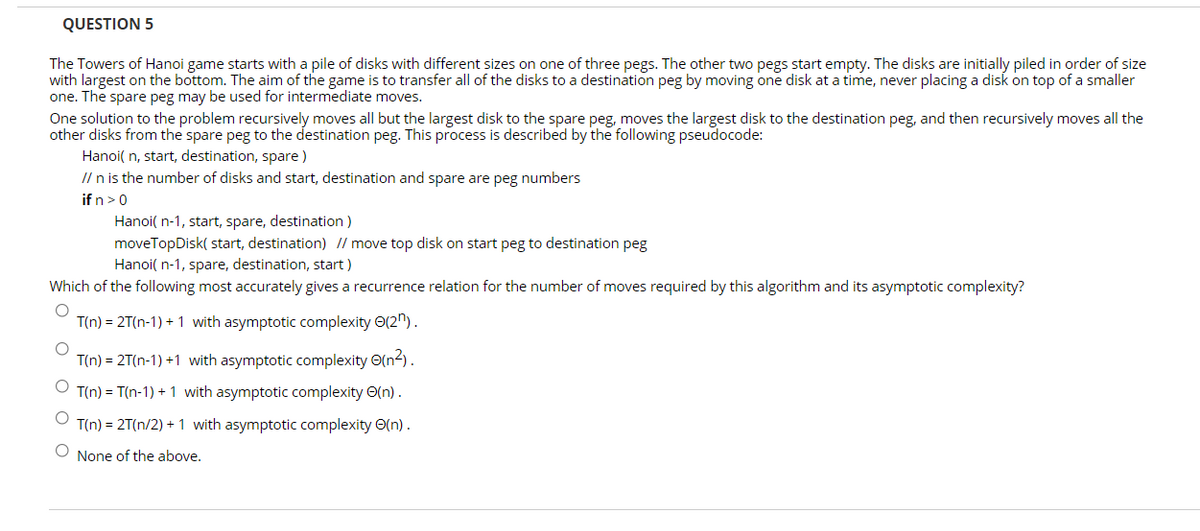QUESTION 5 The Towers of Hanoi game starts with a pile of disks with different sizes on one of three pegs. The other two pegs start empty. The disks are initially piled in order of size with largest on the bottom. The aim of the game is to transfer all of the disks to a destination peg by moving one disk at a time, never placing a disk on top of a smaller one. The spare peg may be used for intermediate moves. One solution to the problem recursively moves all but the largest disk to the spare peg, moves the largest disk to the destination peg, and then recursively moves all the other disks from the spare peg to the destination peg. This process is described by the following pseudocode: Hanoi( n, start, destination, spare ) I/ n is the number of disks and start, destination and spare are peg numbers if n>0 Hanoi( n-1, start, spare, destination) moveTopDisk( start, destination) I/ move top disk on start peg to destination peg Hanoi( n-1, spare, destination, start) Which of the following most accurately gives a recurrence relation for the number of moves required by this algorithm and its asymptotic complexity? T(n) = 2T(n-1) + 1 with asymptotic complexity O(2"). T(n) = 2T(n-1) +1 with asymptotic complexity O(n-). O T(n) = T(n-1) +1 with asymptotic complexity O(n). T(n) = 2T(n/2) + 1 with asymptotic complexity O(n). O None of the above.
QUESTION 5 The Towers of Hanoi game starts with a pile of disks with different sizes on one of three pegs. The other two pegs start empty. The disks are initially piled in order of size with largest on the bottom. The aim of the game is to transfer all of the disks to a destination peg by moving one disk at a time, never placing a disk on top of a smaller one. The spare peg may be used for intermediate moves. One solution to the problem recursively moves all but the largest disk to the spare peg, moves the largest disk to the destination peg, and then recursively moves all the other disks from the spare peg to the destination peg. This process is described by the following pseudocode: Hanoi( n, start, destination, spare ) I/ n is the number of disks and start, destination and spare are peg numbers if n>0 Hanoi( n-1, start, spare, destination) moveTopDisk( start, destination) I/ move top disk on start peg to destination peg Hanoi( n-1, spare, destination, start) Which of the following most accurately gives a recurrence relation for the number of moves required by this algorithm and its asymptotic complexity? T(n) = 2T(n-1) + 1 with asymptotic complexity O(2"). T(n) = 2T(n-1) +1 with asymptotic complexity O(n-). O T(n) = T(n-1) +1 with asymptotic complexity O(n). T(n) = 2T(n/2) + 1 with asymptotic complexity O(n). O None of the above.
Database System Concepts
7th Edition
ISBN:9780078022159
Author:Abraham Silberschatz Professor, Henry F. Korth, S. Sudarshan
Publisher:Abraham Silberschatz Professor, Henry F. Korth, S. Sudarshan
Chapter1: Introduction
Section: Chapter Questions
Problem 1PE
Related questions
Question

Transcribed Image Text:QUESTION 5
The Towers of Hanoi game starts with a pile of disks with different sizes on one of three pegs. The other two pegs start empty. The disks are initially piled in order of size
with largest on the bottom. The aim of the game is to transfer all of the disks to a destination peg by moving one disk at a time, never placing a disk on top of a smaller
one. The spare peg may be used for intermediate moves.
One solution to the problem recursively moves all but the largest disk to the spare peg, moves the largest disk to the destination peg, and then recursively moves all the
other disks from the spare peg to the destination peg. This process is described by the following pseudocode:
Hanoi( n, start, destination, spare )
// n is the number of disks and start, destination and spare are peg numbers
if n>0
Hanoi( n-1, start, spare, destination)
moveTopDisk( start, destination) // move top disk on start peg to destination peg
Hanoi( n-1, spare, destination, start)
Which of the following most accurately gives a recurrence relation for the number of moves required by this algorithm and its asymptotic complexity?
T(n) = 2T(n-1) + 1 with asymptotic complexity O(2").
T(n) = 2T(n-1) +1 with asymptotic complexity O(n2).
O T(n) = T(n-1) + 1 with asymptotic complexity O(n).
T(n) = 2T(n/2) + 1 with asymptotic complexity O(n).
O None of the above.
Expert Solution
This question has been solved!
Explore an expertly crafted, step-by-step solution for a thorough understanding of key concepts.
This is a popular solution!
Trending now
This is a popular solution!
Step by step
Solved in 2 steps

Knowledge Booster
Learn more about
Need a deep-dive on the concept behind this application? Look no further. Learn more about this topic, computer-science and related others by exploring similar questions and additional content below.Recommended textbooks for you

Database System Concepts
Computer Science
ISBN:
9780078022159
Author:
Abraham Silberschatz Professor, Henry F. Korth, S. Sudarshan
Publisher:
McGraw-Hill Education

Starting Out with Python (4th Edition)
Computer Science
ISBN:
9780134444321
Author:
Tony Gaddis
Publisher:
PEARSON

Digital Fundamentals (11th Edition)
Computer Science
ISBN:
9780132737968
Author:
Thomas L. Floyd
Publisher:
PEARSON

Database System Concepts
Computer Science
ISBN:
9780078022159
Author:
Abraham Silberschatz Professor, Henry F. Korth, S. Sudarshan
Publisher:
McGraw-Hill Education

Starting Out with Python (4th Edition)
Computer Science
ISBN:
9780134444321
Author:
Tony Gaddis
Publisher:
PEARSON

Digital Fundamentals (11th Edition)
Computer Science
ISBN:
9780132737968
Author:
Thomas L. Floyd
Publisher:
PEARSON

C How to Program (8th Edition)
Computer Science
ISBN:
9780133976892
Author:
Paul J. Deitel, Harvey Deitel
Publisher:
PEARSON

Database Systems: Design, Implementation, & Manag…
Computer Science
ISBN:
9781337627900
Author:
Carlos Coronel, Steven Morris
Publisher:
Cengage Learning

Programmable Logic Controllers
Computer Science
ISBN:
9780073373843
Author:
Frank D. Petruzella
Publisher:
McGraw-Hill Education